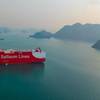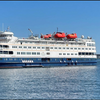Mitsubishi: Innovation on Using LNG as Fuel
Tokyo - Mitsubishi Heavy Industries Ltd. (MHI) has developed Japan's first system for supplying high-pressure gas which will enable use of natural gas as fuel for marine engines. The company agreed with Mitsui Engineering & Shipbuilding Co. Ltd. (MES) for delivery of the first unit.
The use of liquefied natural gas (LNG) as fuel achievable with the new system will enable reduction of carbon dioxide (CO2) emissions, compared with use of heavy oil fuel, thus contributing to reduced environmental burdens. Going forward, MHI will focus on marketing activities to attract orders for high-value-added ships equipped with the new system.
MHI's new high-pressure gas supply system delivers LNG at 30 megapascals (MPa) gas by liquid pumping, and it is characterized by its compact configuration and lower power consumption. A hydraulic driver is adopted for the liquid pump without speed reduction mechanism, which facilitates variable speed adjustment and high flexibility of layout.
The company commercialized the system by leveraging its broad technological base and R&D achievements, not only in cryogenics, field-backed with long experience of building of LNG carriers, but also in the area of marine engine field, general machinery and sealing.
The system consists mainly of a unit to transfer LNG at high pressure, according to fluctuations in the demand of the engine, a hydraulic unit as power source, a unit to produce a compressed natural gas (CNG) by heating LNG to its normal temperature, a CNG bottle unit to buffer the CNG pressure variation, and gas combustion unit to safely dispose low pressure off-gas and to use its exhaust heat as heat source.
In combination of the system with 2-stroke, low-speed marine diesel engines, the engine will be a high efficiency propulsion system. . By using LNG as its fuel, an engine integrated with the new system also realizes reductions in emissions of sulfur oxides (SOx) and nitrogen oxides (NOx).
Delivery of the first unit to MES is slated to take place in early 2013. After installation at MES's Tamano Works in Tamano, Okayama Prefecture, the system will be employed for verification demonstration using marine diesels, which are manufactured by MES.









